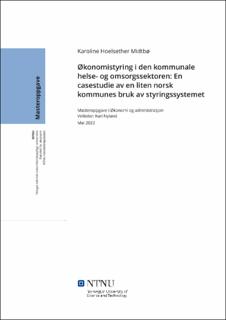| dc.contributor.advisor | Nyland, Kari | |
| dc.contributor.author | Midtbø, Karoline Hoelsether | |
| dc.date.accessioned | 2022-09-16T17:20:18Z | |
| dc.date.available | 2022-09-16T17:20:18Z | |
| dc.date.issued | 2022 | |
| dc.identifier | no.ntnu:inspera:112632672:114448228 | |
| dc.identifier.uri | https://hdl.handle.net/11250/3018599 | |
| dc.description.abstract | Den kommunale helse- og omsorgssektoren står ovenfor store utfordringer de kommende årene med økende behov for helsetjenester samtidig som driften må effektiviseres da det økonomiske spillerommet forventes å bli mindre. Kommunene må løse utfordringer knyttet til manglende kapasitet samt økende utfordringer knyttet til å skaffe nok kompetent personell. Formålet med studien er å belyse hvordan en kommune bruker styringssystemet for å kunne imøtekomme morgendagens behov, og følgende problemstilling ligger derfor til grunn for studien:
Hvordan brukes styringssystemet for å nå målene i den kommunale helse- og omsorgstjenesten?
For å belyse denne problemstillingen har jeg gjennomført en casestudie i en relativt liten norsk kommune som skårer godt på nasjonale rangeringer. Studien er avgrenset til å se nærmere på to av kommunens helseenheter, hjemmetjenesten og helsesenteret. Disse enhetene samarbeider mye og har i stor grad de eldre pasientene. Studiens datagrunnlag består av sju kvalitative dybdeintervjuer samt dokumentstudier av flere av kommunens plan- og måldokumenter. Rammeverket til Simons (1995b) benyttes for å diskutere bruken av styringssystemet, og ideen om å se på økonomistyring som pakker presentert av blant annet Malmi og Brown (2008) og Hopwood (1974) anvendes for å belyse styringssystemets sammensetning og betydningen av de uformelle styringsverktøyene.
Styringssystemet i kommunen er komplekst og sammensatt. Studien viser i så måte at kommunens sosiale styringsmekanismer og organisasjonskultur som er preget av faglig fokus, stor tillit til hverandre, lojalitet til tjenestevei, nære relasjoner og en grunnleggende innstilling til samarbeid er viktig for styringen av kommunen. De uformelle styringsverktøyene utfyller de formelle, og reduserer behovet for stram styring. Til tross for at den kommunale helsesektoren preges av utstrakt lovverk, mye rapportering og politisk styring, opplever studiens enhetsledere stor handlingsfrihet og mulighet til å bruke sin kompetanse til å finne løsninger innad i sin enhet. Kommunen bruker altså sitt styringssystem på en tilsynelatende balansert måte hvor behovet for kontroll gjennom eksempelvis plansystemet og den utstrakte rapporteringen balanseres ut gjennom dialog og verdier som tillit, for å muliggjøre frihet. På denne måten søker de å nå målene sine om å tilby alle kommunens innbyggere et godt og verdig liv til siste slutt. | |
| dc.description.abstract | The municipal health and care sector faces major challenges in the coming years with an increasing need for health services at the same time as operations must be made more efficient as the financial room for maneuver is expected to be smaller. The municipalities must solve challenges related to lack of capacity as well as increasing challenges related to obtaining sufficient competent personnel. The purpose of the study is to shed light on how a municipality uses the management control system to be able to meet tomorrow’s needs, and the following problem is therefore the basis for the study:
How is the management control system used to achieve the goals in the municipal health and care service?
To shed light on this issue, I have conducted a case study in a relatively small Norwegian municipality that scores well on national rankings. The study is limited to a closer look at two of the municipality’s health units, the home care service and the health center. The study’s data base consists of seven qualitative in-dept interviews as well as document studies of several of the municipality’s planning and target documents. The framework of Simons (1995b) is used to discuss the use of the management system, and the idea of looking at management control as packages presented by Malmi and Brown (2008) and Hopwood (1974) is used to shed light on the composition of the management control system and the importance of informal management tools.
The management control system in the municipality is complex. The study thus show that the municipality’s social management mechanisms and organizational culture are important for the management of the municipality. The informal management tools complement the formal ones, and reduce the need for tight control. Despite the fact that the municipal health sector is characterized by extensive legislation, a lot of reporting and political control, the study’s unit leaders experience great freedom of action and the opportunity to use their expertise to find solutions within their unit. The municipality thus uses its management control system in a seemingly balanced way where the need for control through, for example, the planning system and the extensive reporting is balanced out through dialogue and values such as trust to enable freedom. In this way, they seek to achieve their goals of offering all the municipality’s inhabitants a good and dignified life to the end. | |
| dc.language | nob | |
| dc.publisher | NTNU | |
| dc.title | Økonomistyring i den kommunale helse- og omsorgssektoren: En casestudie av en liten norsk kommunes bruk av styringssystemet | |
| dc.type | Master thesis | |
